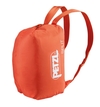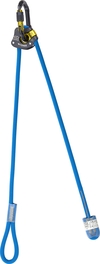La Legrima, Adam Holzknecht and Hubert Moroder make first ascent of the icefall on Sassolungo North Face
1000 metres up one of the most important north faces in the Dolomites. A thin drip of ice, a fleeting tear "spied" and dreamt of by many strong ice climbers. And finally, as always, along came someone capable of seizing the moment. On 7 and 8 January Adam Holzknecht and Hubert Moroder ascended that slender thread of ice, that Legrima (which means tear in local Ladin language) up the great north face, the immense peak which has become the symbol of Val Gardena and those lands. The two alpinists pulled it off in perfect style, in their "minimum" and rigorous style. They set out up this difficult and long climb with just 10 pegs, 10 ice screws, a set of friends and no bolts. After two days, and an uncomfortable bivouac at half-height, they reached the summit of Sassolungo and enjoyed the deserved "stay" in the bivy below, beneath a fabulous starry night. Before leaving you with the enticing ascent story sent to us by Flavio Moroder (brother of Hubert and also president of the South Tyrolean Mountain Guides), we simply wish to emphasize that "minimum" style with which Legrima was climbed. A quick glance at the route topo reveals all: in total only 3 pegs were used along the route, plus a further 3 at the belays. All the rest, more than 1000m, were protected by "poor" ice screws and friends only. With regards to the difficulties suggested by the two first ascentionists - WI6 M6 V+ and two sections of A0 - we'd like to point out that the first use of aid was on pitch 1, while the other on pitch 9. Adam Holzknecht told Planetmountain he hopes someone will free these sections and thus make the first free ascent. We believe, and this is our consideration, that on a route as long, complicated and "precarious" as Legrima those two sections on A0 don't take anything away from its overall beauty and difficulty. Furthermore, we'd like to underline the fact that declaring this aid is by no means something which can be taken for granted. And for us, this too is an indication of great style.
"Legrima" The tear that drops down Sassolungo. The extraordinary journey of the two Catores Mountain Guides Adam Holzknecht and Hubert Moroder (text by Flavio Moroder)
The 1000 metre high North Face of Sassolungo is one of the biggest faces in the Dolomites and a prime destination for those climbers who still search for true adventure in the mountains. Apart from the classic Pichlführe, there are several other routes which are more difficult and all are considered severe alpine outings. Those who have climbed the North Face via the Pichl route have surely noticed that after approximately 250 metres one reaches a first big traverse. A small waterfall forms above this and originates from the top of Sassolungo. The Ladin people called this place "sal‘ega".
In recent years, ever since ice climbing has grown in popularity and above all with the advent of dry tooling, numerous renowned alpinists have observed and studied this amazing strip of ice. But autumn rains had never been abundant enough to form a proper icefall, until last autumn, which this winter finally resulted in a more continuous sliver of ice. Due to the steepness though the drip didn't form continuously from top to bottom.
Nevertheless, the two climbers thought it was worth attempting. Adam Holzknecht and Hubert Moroder are well known for their winter undertakings on the most difficult peaks in the Dolomites and further afield, too (many will remember their record-breaking ascent of Fitz Roy and Cerro Torre in just four days) and on Monday 7 January they set off early to reach the base of the wall. The approach proved tiring because they continued to sink into the snow which here, on the north face, had amassed in abundance.
The first 250 metres were shared with the Pichl route. In summer this section has no particular difficulties as it never exceeds grade IV climbing, but the completely snow-plastered face presented the duo with challenging conditions. At about 11.00 am, after three and a half hours of demanding climbing, they reached the first traverse and this is where the real adventure began: a 350m high precarious layer of ice up the completely vertical face. Only Adam's extraordinary technical ability and unique climbing style enabled them to breach sections previously believed nigh impossible. It should be emphasized that, true to their mountaineering ethics, Adam and Hubert had only set off with 10 pegs, 10 ice screws and a set of Friends.
At around five in the afternoon our climbers had negotiated about half of the ice drip and had to find a relatively flat section to spend the night. They dug a small niche next to the gully and crept into their sleeping bags, clipped to the belay and five metres apart, and prepared themselves for the long night ahead. Above and below them lay the vertical wall, in front of them they were greeted by the breath-taking view of lights that illuminate Val Gardena and, not far away, the Comici hut where abundant dishes of fish were being served. Obviously there were those who alerted the Mountain Rescue service after having noticed the beams in the middle of Sassolungo's north face, but the Val Gardena rescue service was already aware of the folly of its president and vice president.
The night was not particularly cold and it wouldn't have been too bad had it not been for the strong north wind which picked up at nine and continued throughout the night. To save weight the two climbers had taken only one bivy bag, but since they had failed to find a ledge big enough for the two of them, Adam spent the night wrapped only in his sleeping bag, exposed to the strong wind and seeping snow. It's easy to imagine who hard preparations must have been the next morning before they set off, once again up into the unknown.
The first three pitches were extremely difficult and their ice screws only half-penetrated into the very thin layer of ice, thereby making the ascent even more arduous. To make matters worse, the incessant wind continued to sweep spindrift down onto the climbers. Fortunately some threads and Friends placed on the side of the drip provided additional safety. Adam, who is second to none in terms of courage and class in the mountains, placed just three pegs along the pitches and another three at the belays. At around 13:00 the two finally completed the steepest section of the drip and "all" that remained now were the remaining 400 snowy metres to the summit. The recent high winds had made the snowpack hard meaning that although the ascent was not tricky, it was nevertheless difficult to protect.
At around 16:00 the two climbers reached the summit of Sassolungo, exhausted, happy and with tremendously aching arms after having clung on to their ice axes for two days. They were greeted with a breath-taking landscape, but what was important now was to reach the abseil ring and descend to the bivy for a well-earned rest. No five-star hotel is more luxurious than the Sassolungo bivy for someone who has just spent a night out on the wall.
The next morning the two prepared their gear and descended via the normal route. Those who've climbed Sassolungo via this line in winter know of its difficulties and Adam and Hubert, accustomed to far more, descended in less than two hours, reached the Piani di Confin on foot and hitched a lift to Monte Pana from a bus which happened to drive past
The Catores Mountain Guides are honoured to have two great climbers like Adam Holzknecht and Hubert Moroder in the midst who, with this undertaking, have contributed once again to the history of climbing in the Dolomites.
Flavio Moroder
Legrima, Sassolungo North Face
First ascent: Adam Holzknecht and Hubert Moroder. 7 and 8 January 2013
Grade: WI6 M6 V+, two sections of A0
Gear: 3 pegs along the pitches, 3 pegs at the belays, all left in-situ.
Equipment: a set of friends, 10 ice screws, mainly short, some pegs the most part short and some nail rock.
Reckon with a bivouac on the face.
See the route topo
| www | |
| www.catores.com | |


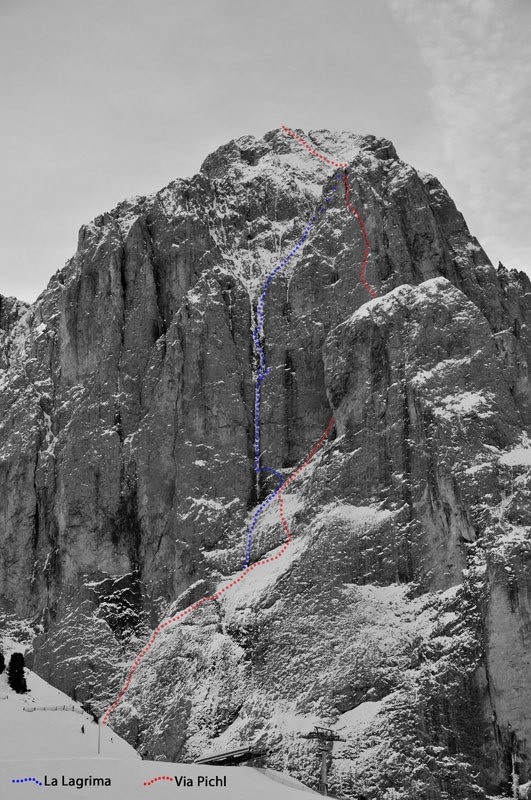
 1 / 10
1 / 10
 Copia link
Copia link

 Werner Dejori
Werner Dejori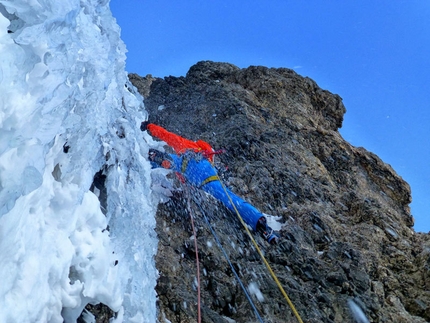
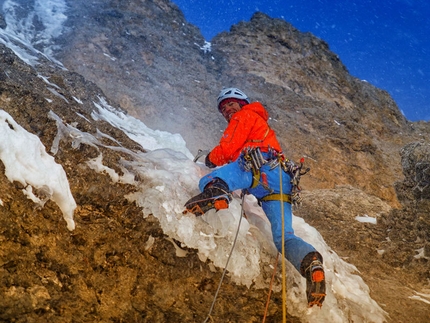
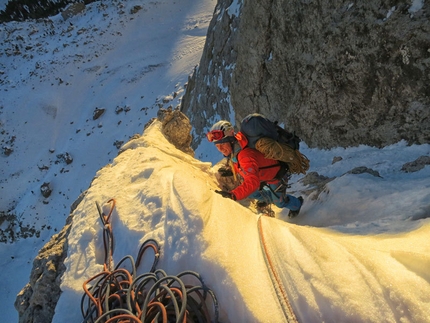
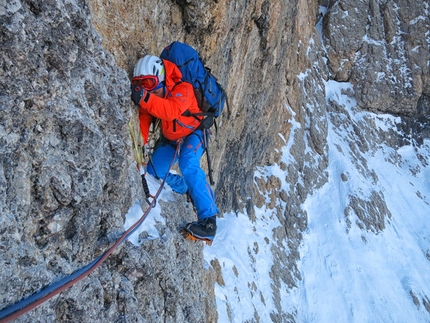
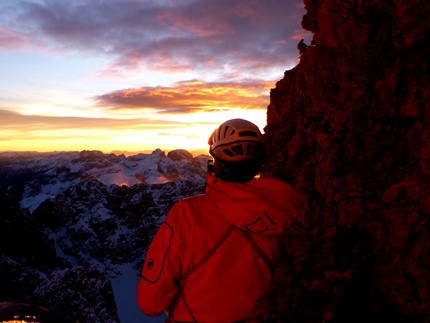
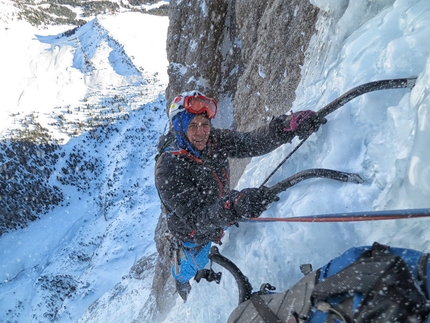
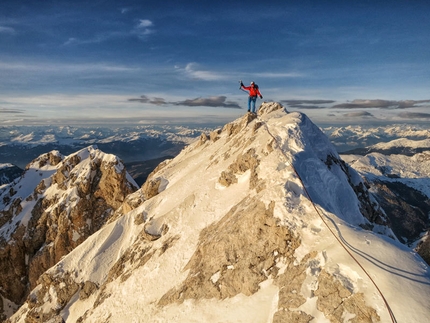
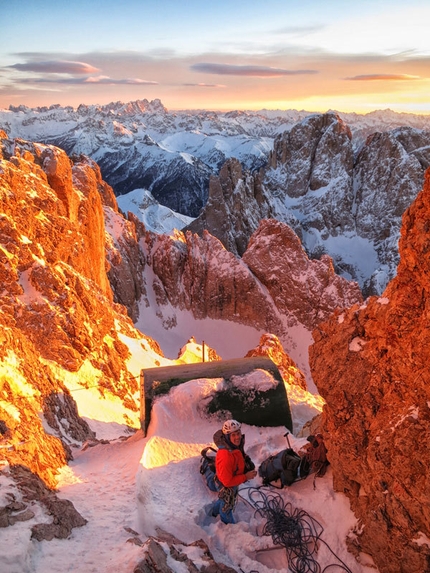
 See all photos
See all photos



















